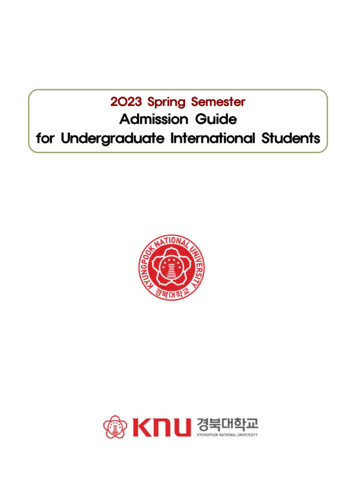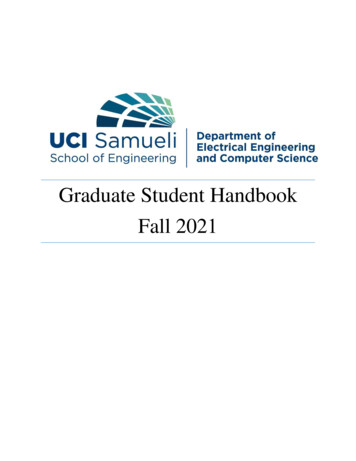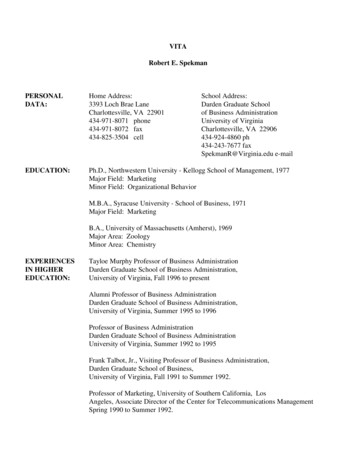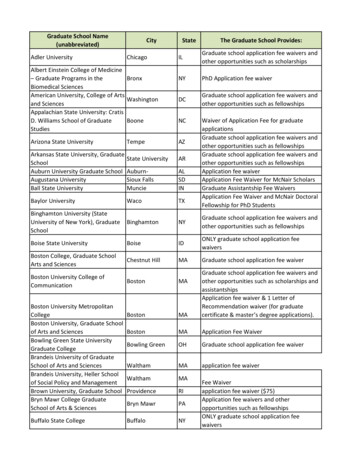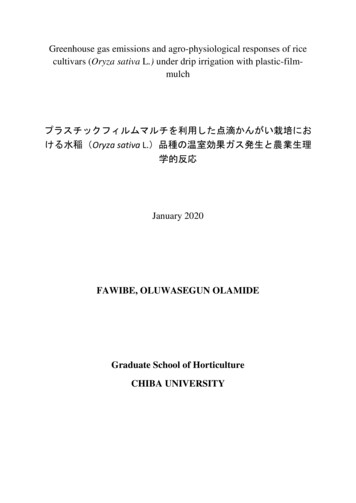
Transcription
Greenhouse gas emissions and agro-physiological responses of ricecultivars (Oryza sativa L.) under drip irrigation with �ける水稲(Oryza sativa 理学的反応January 2020FAWIBE, OLUWASEGUN OLAMIDEGraduate School of HorticultureCHIBA UNIVERSITY
[千葉大学学位申請論文]Greenhouse gas emissions and agro-physiological responses of ricecultivars (Oryza sativa L.) under drip irrigation with �ける水稲(Oryza sativa 理学的反応January, 2020A thesis submitted to Graduate School of Horticulture, ChibaUniversity, in partial fulfillment of the requirements for the degree ofDoctor of Philosophy (Ph.D.)FAWIBE, OLUWASEGUN OLAMIDELaboratory of Crop ScienceGraduate School of HorticultureCHIBA UNIVERSITYi
APPROVALGreenhouse gas emissions and agro-physiological responses of ricecultivars (Oryza sativa L.) under drip irrigation with �ける水稲(Oryza sativa 理学的反応January 2020FAWIBE, Oluwasegun OlamideApproved by:Prof. Akihiro ISODA (Ph.D.) (Supervisor) Prof. Kazuyuki INUBUSHI (Ph.D.) (Reviewer) Prof. Toru MARUO (Ph.D.) (Reviewer) Prof. Nobuhiro MATSUOKA (Ph.D.) (Reviewer) .ii
LIST OF CONTENTSContentPageTitle Page .iApproval .iiList of contents .iiiList of Figures .viiList of Tables .ixList of Plates .xAcknowledgments xiDedication xiiAbstract (English) .xiiiAbstract (Japanese) .xvCHAPTER ONE: GENERAL INTRODUCTION1.1 Background of study 11.2 Emission of Greenhouse gases .31.2.1 The contribution of rice field to anthropogenic methane emission .31.2.2 Transfer of methane from soil to the atmosphere .51.2.3 Nitrous oxide emission from rice field .61.2.4 Effects of irrigation and fertilization on N2O fluxes .71.3 Irrigation and crop production. .9iii
1.3.1 Effect of drip fertigation on crop improvement .101.3.2 Effect of mulch on crop production amd improvement .111.3.3 Rice cultivation and water management .121.3.4 Rice cultivation with drip irrigation and plastic-film-mulch .151.3.5 Physiological response of rice cultivars to stress .161.4 Justification of the study 181.5 Aim of the study .19CHAPTER TWO: Greenhouse gas emissions from rice field cultivation with dripirrigation and plastic-film-mulch2.1 Introduction .202.2 Materials and methods .232.2.1 Site description .232.2.2 Treatments and field management .252.2.3 Water management .302.2.4 Preparation of evacuated glass vials 322.2.5 Gas sampling . .352.2.6 Preparation of standard gas and sample analysis 382.2.7 Soil analyses 402.2.8 Grain yield analysis .402.2.9 Statistical analysis .412.3 Results .422.3.1 Irrigation volume and soil characteristics .422.3.2 Methane fluxes 442.3.3 Nitrous oxide fluxes 46iv
2.3.4 CO2 equivalent emission . .482.3.5 Grain yield and yield components .502.4 Discussion .522.5Conclusion . 56CHAPTER THREE: Agro-physiological responses of rice cultivars (Oryza sativa L.) asinfluenced by different fertilization methodology under drip irrigation with plastic-filmmulch3.1 Introduction 573.2 Materials and methods 603.2.1 Plant materials and site description .603.2.2 Experimental design and treatments .613.2.3 Fertilization procedure under drip irrigation with plastic-film-mulch 673.2.4 Plant sampling and analyses 713.2.5 Physiological measurements .723.2.6 Grain quality measurements 733.2.7 Statistical analysis .743.3 Results 753.3.1 Weather and hydrological conditions .753.3.2 The number of tiller of rice cultivars under varying irrigation systems .793.3.3 Soil available iron concentration under varying irrigation systems . 813.3.4 Chlorophyll contents of rice cultivars under varying irrigation systems . .833.3.5 Leaf area index and dry matter accumulation of rice cultivars under varying irrigationtreatments .85v
3.3.6 Photosynthesis associated parameters of rice cultivars under varying irrigationsystems .883.3.7 Grain yield and water-use efficiency of rice cultivars under varying irrigationsystems .913.3.8 Grain qualities of rice under varying irrigation systems .963.4 Discussion .993.5 Conclusions .104CHAPTER FOUR: GENERAL DISCUSSION AND CONCLUSION4.1 General discussion .1054.2 General conclusion and recommendation. .112REFERENCES .113vi
LIST OF FIGURESFigurePage2-1. Soil temperature, soil moisture, amount of rainfall, and average air temperature duringthe rice-growing season in 2016 and 2017 242-2. Drip irrigation with plastic-film-sketched layout with planting row-spacingconfiguration .272-3. Biweekly methane emissions under drip irrigation with plastic-mulch and continuousflooding systems during the rice-growing seasons of 2016 and 2017 .452-4. Biweekly nitrous oxide emissions under drip irrigation with plastic-mulch andcontinuous flooding systems during the rice-growing seasons of 2016 and 2017 .473-1. Standard absorption curve for the determination of soil available Fe concentration undervarying irrigation systems in 2017 .703.2. Weekly averages of daily air-temperature and daily rainfall during the rice-growingseasons of 2017 and 2018 763-3. Change in volumetric soil moisture content under drip irrigation with plastic-mulchsystems during rice-growing seasons of 2017 and 2018 .783-4. The number of tillers per square meter of rice cultivars under varying irrigation systemsduring the rice-growing seasons of 2017 and 2018 .803-5. Soil available Fe concentration under varying irrigation systems at the mid-tillering stageof rice in 2017 .823-6. SPAD values of rice cultivars under varying irrigation treatments during rice-growingseasons of 2017 and 2018 .84vii
3-7. Leaf area index (LAI) and dry matter of rice cultivars under varying irrigation systemsduring the rice-growing seasons of 2017 and 2018 86viii
LIST OF TABLESTablePage2.1. Field management practices during rice growing seasons of 2016 and 2017 .282.2. Irrigation, rainfall, and total water input in continuous flooding and drip irrigation withplastic-mulch systems during rice-growing seasons of 2016 and 2017 .312.3. Time schedule for sample measurements during a 20-min closure with 3-chambers in anexperimental plot .372.4. Effect of drip irrigation with plastic-mulch on soil total carbon, total nitrogen, andmineralizable nitrogen at different stages of rice growth in 2017 .432.5. Effect of drip irrigation with plastic-mulch on the accumulated CH4 and N2O emissionsand global warming potential during the 2-year growing seasons 492.6. Effect of drip irrigation with plastic-mulch on grain yield and yield components of riceduring the 2-year rice growing seasons .513.1. The amount of irrigation water, rainfall and total water input under varying irrigationsystems during the rice-growing seasons of 2017 and 2018 .773.2. CO2 assimilation rate, transpiration rate, stomatal conductance, and chlorophyllfluorescence parameters of rice cultivars at the grain-filling stage under varying irrigationsystems in 2017 and 2018 . .893.3 Grain yield and its components, water use efficiency and harvest index of rice undervarying irrigation systems in 2017 and 2018 .933.4. Appearance, cooking, and nutritional qualities of rice cultivars under varying irrigationsystems during rice-growing seasons of 2018 .98ix
LIST OF PLATESPlatePage2.1. Preparation of evacuated glass vials 332.2. Glass vials evacuation process using vacuum-pumped apparatus .342.3. Gas sampling using a closed chamber method .362.4. Preparation of standard gas and sample analyses .393.1. Experiment plots of the continuous flooding system with direct seeding 633.2. Experiment plots of the drip irrigation with plastic-mulch systems .643.3. Volumetric soil moisture measurement with FDR probe sensor under drip irrigation withplastic-mulch systems .653.4. Tillering stage of rice growth under varying irrigation systems .663.5. Drip fertigation using liquid fertilizer injector (DOSATRON) 683.6. Fe chlorosis at the mid-tillering stage of rice cultivars under drip irrigation with plasticmulch system in 2017 . .693.7. Rice grain yield at maturity stage under varying irrigation systems . 95x
ACKNOWLEDGMENTSI am grateful to Almighty God for the successful completion of this program. My profoundgratitude goes to my major supervisor (Professor Akihiro Isoda) for granting me theacceptance to carry out this project in his laboratory. I am also thankful for the love, care,guidance and full support that he extended to me throughout my study. I am also indebted tomy advisory committee, Professor Toru Maruo, Professor Kazuyuki Inubushi and ProfessorNobuhiro Matsuoka for their contributions to this project. My cordial thanks go to ProfessorKazuyuki Inubushi for his guidance and also for providing the laboratory assistance for animportant aspect of this research.My deepest appreciation goes to the Japanese Ministry of Education, Culture, Sports,Science, and Technology (MEXT) for the educational-based investment they made in methrough the Monbukagakusho scholarship program to fund my study. My gratitude also goesto other sponsors of this project: Japan Society for the Promotion Science (JSPS KAKENHI)(JP 16K07570); Xinjiang Tianyuan Institute of Rice Drip Irrigation System, and ChibaUniversity SEEDS Fund (Chiba University Open Recruitment for International ExchangeProgram) for the grants provided. These aided the successful completion of the research andpresentation of results at international conferences.I offer my sincere thanks to my research team (Kanako Honda, Yuki Taguchi, Motofumi,Hiramatsu, Junfa Wang) and other members of the laboratory of crop science that contributedto the success of this work. Your labor of love will forever linger in my heart.My sincere appreciation goes to my affiliated (home) institution (Federal University ofAgriculture Abeokuta, Nigeria) for the approval of my study leave without withholding otherbenefits. Also, I am grateful to all the staff of the Department of Pure and Applied Botany(FUNAAB) under the leadership of Professor (Mrs) I.A Kehinde for their support andassistance while staying out of the key departmental responsibilities. God bless you all.Finally, I am indebted to my family, my in-laws, friends, members of Matsudo city church,all love beings for their prayers and good wishes. I love you all.xi
DEDICATIONThis thesis is dedicated to my wife (Kehinde Oluwaseyi Fawibe) and my lovely twins (Taiwoand Kehinde Fawibe) whose love, sacrifice, support, and encouragement have motivated meto pursue and complete this research. You are the true champions!xii
ABSTRACTThe increased competition for water and the substantial environmental impacts ofconventional rice production has intensified the search for the most efficient water-savingrice production system capable of mitigating greenhouse gas emissions without yield loss. A3-year field experiment was conducted to quantify greenhouse gas emissions (GHGs) and toinvestigate agronomical and physiological responses of rice cultivars under drip irrigationwith plastic-film-mulch. CH4 and N2O were quantified and contrasted in drip irrigation withdirect fertilization under plastic-film-mulch (DPD) and continuous flooding (CF) systems in2016 and 2017. Moreover, the grain yield, grain quality, and water-use efficiency (WUE) ofrice as influenced by different fertilizer application methods under drip irrigation with plasticfilm-mulch were investigated in 2017 and 2018. As a result, drip fertigation with plasticmulch (DPF) was included in 2017 and 2018. Koshihikari (a lowland Japonica cultivar),Norin 24 (an upland Japonica cultivar) and Princessari (a lowland cultivar; a derivative fromIndica and Japonica crosses) were used in 2017, whereas only two cultivars (Koshihikari andNorin 24) were used in 2018. In 2017, the cumulative CH4 emission under both irrigationsystems was higher than in 2016. Compared with CF, DPD reduced CH4 emission by 194%and 96% in 2016 and 2017, respectively. However, low and insignificant N2O emissions wereobserved under both irrigation regimes. This was attributable to low nitrogen fertilization anda probable discontinuous aerobic-soil condition. The 2-year average CO2 equivalent (CO2eq)emission of the CF was 9 times greater than that of the DPD. The grain yields of Koshihikariand Norin 24 were not significantly different under DPF and DPD compared with CF. Thesewere ascribed to the comparable photosynthesis associated parameters at the grain-fillingstage. The high yields obtained under DPF and DPD were attributed to the increase in thenumber of spikelets per panicle. However, the deficiency of available soil Fe and mild waterstress decreased the leaf SPAD value and maximum quantum yield (Fv/Fm) of photosystemxiii
II (PSII) of Princessari. These resulted in a grain yield reduction of 65% and 54% under DPFand DPD, respectively, compared with CF. The DPF and DPD increased WUEs ofKoshihikari and Norin 24 by 40-74% and improved rice nutritional quality but increased thechalky grain percentage. The DPF and DPD similarly influenced the grain yield and grainquality; nonetheless, the DPD had a greater water-saving capacity. The study demonstratedthat, with cultivars adaptable to Fe deficiency in the soil and mild water stress, drip irrigationwith plastic-film-mulch could significantly increase WUE while maintaining grain yield thatis comparable to that under CF with reduced environmental impact. Therefore, DPF or DPDcould be an efficient water-saving rice production system in areas with limited waterresources.xiv
しかxv
と大幅に減少した. ��いものと考えられた.xvi
CHAPTER ONEGENERAL INTRODUCTION1.1 Background of studyAgricultural practices such as irrigation and fertilization are essential for crop improvementand plant growth but these also increase greenhouse gas (GHG) emissions from the soil to theatmosphere. Greenhouse gas emissions from agricultural land have been estimated to accountfor 13.5% of anthropogenic emissions worldwide (IPCC, 2007). Improving agriculturalpractices is a recommended strategy for mitigating GHG emissions from agricultural soilswithout incurring yield loss (Wu et al., 2014). However, this strategy greatly depends on croptypes.Rice crops require a substantial amount of fresh water because it is mostly grown under acontinuous flooding system also referred to as paddy (Tuong and Bouman, 2003; Bouman etal., 2007). This cultivation method is most common in Asia where more than 75% of theworld‟s rice is being produced (Cantrell and Reeves, 2002); making irrigated rice productionimportant to the present and future food security. It is quite infelicitous that despite thecontribution of paddy field towards feeding the growing population and ensuring sustainablefood production, its adverse role in the environment cannot be underestimated. Riceproduction has environmental impacts, largely by releasing gases to the atmosphere,therefore, becoming a significant source of greenhouse gases that contribute largely toclimate change. The magnitude and pattern of methane (CH4) emissions from rice fields aredetermined mainly by the water regime and organic inputs and to a lesser extent by soil type,weather, tillage practices, residue management, and rice cultivar (Dickie et al., 2014).In irrigated rice systems with good water control, nitrous oxide (N2O) emissions arenegligible except when nitrogen fertilizer rates are excessively high. In irrigated rice fields,1
the bulk of nitrous oxide emissions occur during fallow periods and immediately after theflooding of the soil at the end of the fallow period (Kreye et al., 2007). In rainfed systems,however, nitrate accumulation in aerobic phases might contribute to considerable emission ofnitrous oxide.Water is essential for the growth and development of rice plants. Continuous flooding (CF)provides favorable water and nutrient supply under anaerobic conditions. The significance ofthis system relates to the high yield and quality of rice production. This could be attributed tohigh soil microbial biomass and soil organic matter under flooded conditions. In paddy,decomposition of soil organic matter is slow leading to a gradual release of nutrients to therice plant. Also, the presence of high soil microbial biomass enables the soil to be rich innitrogen. However, the conventional system consumes a large amount of water. It has beenestimated that the continuous flooded rice production system takes 3000 to 5000 liters ofwater to produce 1 kilogram of rice. This is 2-3 times more than to produce 1 kilogram ofother cereals such as wheat and maize (Bouwman et al., 2002).Water has been reported to be the most precious resource. Nonetheless, the increasing worldpopulation, industrialization, urbanization and the development of other economic indiceshave intensified competition for available water resources (Tuong and Bouman, 2003;Bouman, 2007). This has led to a significant decrease in freshwater availability foragricultural production. With limited water, farmers are facing a challenge to produce morerice per unit of land to meet the food demand of a growing population. Therefore, to ensurefood security while reducing the agricultural impact of GHGs concentration in theatmosphere, rice cultivation systems that incorporate water-saving methods with greatpotential to mitigate greenhouse gases emission need to be established. Thus, enabling tocope with potential water deficit and ensuring that the demand for rice continues to be met ina sustainable environment.2
1.2 Emission of Greenhouse gasesHuman activities are estimated to have caused approximately 1.0 C of global warming abovepre-industrial levels, with a likely range of 0.8 C to 1.2 C. Global warming is likely to reach1.5 C between 2030 and 2052 if it continues to increase at the current rate (IPCC, 2018).Methane (CH4) and nitrous oxide (N2O) are important greenhouse gases (GHGs) in theatmosphere that have been receiving more attention in recent years (Li et al., 2014). Thisdoes not only result from their rapid increase in concentration in the last century caused byanthropogenic and natural emissions but also as a result of their strong infrared absorptioncapacity and large warming effects in the atmosphere (Fender et al., 2012). The globalwarming potential (GWP) of a single molecule of CH4 and N2O is 28 times and 265 timesthat of carbon dioxide (CO2) respectively, for a period of 100 years (IPCC, 2014).Methane sources are divided into biological and non-biological sources. The biologicalsource consists of wetlands, termites, oceans, landfills, ruminants and paddy fields. Nonbiological sources include biomass burning and fossil fuel origins such as hydrates, mining,and transport. Both types comprise the anthropogenic and natural emissions. Theanthropogenic CH4 emission accounts for 60-70% of the total CH4 emission (Hein et al.,1997; Fung et al., 1991).1.2.1 The contribution of rice field to anthropogenic methane emissionThe increase in demand for food as a result of the steady increase in population hasnecessitated the increase in rice production. Therefore, a further increase in methane emissionfrom rice fields has become a matter of concern. The lowland rice field is one of the mostimportant sources of CH4 emission. Although methane is not toxic when inhaled but it is animportant greenhouse gas accounting for 15% of the total enhanced greenhouse effect (Jain etal., 2004). The staying time of this gas in the atmosphere is relatively short (10 years) as3
compared to other greenhouse gases (GHGs) such as CO2 (100 years) and N2O (170 years).Therefore, the reduction of global methane sources offers possibilities for curtailing theincreasing trend of global warming on a short time scale.Carbon substrates for methanogenesis are supplied from applied organic matter, exudates andsloughed tissues of rice plants, and soil organic matter. CH4 is produced by the reduction ofcarbon substrates by methanogens under strictly anaerobic conditions with an approximateredox potential from -150 to -160mV (Wang et al., 1993). The anaerobic condition occurs inthe paddy as a result of soil submergence that limits the transport of oxygen into the soil.Under this condition, microorganisms start to use alternative electron acceptors in theirrespiration causing further soil reduction. The redox potential reduces sharply and thus leadsto methanogenesis.Under anaerobic and reduced conditions, methanogens produce methane from either thereduction of CO2 and H2 (Hydrogenotrophic) or from the fermentation of acetate to CH4 andCO2 (acetotrophic) (Deppenmier et al., 1996). Under steady-state conditions in anoxic ricefields, the acetotrophic pathway is dominant and accounts for about 78-80% of the total CH4emitted. These bacteria being strictly anaerobic, convert fermentation products formed byother microorganisms, notably CO2, H2, esters, salt of methanoic acid (HCOOH), and othersubstrates into CH4 (Cicerone and Oremland, 1998). The reactions with reference to the typeof methanogens involved in forming CH4 as an end product were illustrated by Papen andRennenberg (1990).(a) H2 reduction of CO2 by chemoautotrophic methanogensCO2 4H2CH4 2H2O(b) Several strains of methanogens can also use HCOOH or CO as a substrate formethane production4
4HCOOHCH4 3CO2 2H2O4CO 2H2OCH4 3CO2(c) Methane can also be produced by methylotrophic methanogens, which use methylgroup containing substrates such as methanol and acetate.4CH3OH3CH4 CO2 2H2OCH3COOHCH4 CO2In contrast, there are some aerobic microsites in rice soils which function as a sink formethane. These enable the transformation of methane to CO2 by the oxidation process carriedout by methanotrophic bacteria. Methanotrophs are a subset of the physiological group ofmethylotrophs, which utilize a variety of one-carbon compounds. Some of themicroorganisms responsible for the oxidation of CH4 are strictly aerobic, obligate methyl- ormethanotrophic eubacteria. These microorganisms can use CH4 and C1 compounds such asmethanol and methylated compounds containing sulfur as substrates (Richard and Thomas,1996).1.2.2 Transfer of Methane from soil to the AtmosphereThe emission of methane from the soil to the atmosphere involves different regulatingprocesses. However, CH4 emission is mostly transported through rice plants. Similar to thetransport of O2 and some other gases in several aquatic plants, aerenchyma helps in thetransport of gaseous CH4 in rice. The path includes diffusion into the root, conversion intogaseous CH4 in the root cortex, diffusion through cortex and aerenchyma and the release tothe atmosphere through micropores in the leaf sheath (Schutz et al., 1989). A shift in the CH4transport pathway was observed by Wang et al. (1997) that about 50% of CH4 were releasedfrom the leaf blades before shoot elongation, whereas only a small amount was emittedthrough leaves as plants grew older. In addition to the presence of the micropores of the leaf5
sheath, Wang et al. (1997) identified cracks in junction points of internodes. Although CH4can also be released through panicles, this pathway is negligible as long as leaves and nodeswere not submerged. Nouchi et al. (1990) have also reported that CH4 was mostly releasedfrom the culms of rice plants. Moreover, the ebullition of gases entrapped in sediments andpeats has also been identified as a possible path for methane emission to the atmosphere. Theebullition process could be influenced by many factors like wind speed, flood watertemperature, solar radiation, flood water level, and atmospheric pressure. The contribution ofebullition to the total CH4 emission is not more than 20%. The emissions from the unplantedfields were almost exclusively due to ebullition. In Japan, Takai and Wada (1990) hadobserved that the ebullition of CH4 is important during the early stage of flooding when riceplants are small, whereas vascular transport becomes more important as the rice plants getolder.In addition, diffusion is another pathway. Nonetheless, this has an infinitesimal contributionto CH4 emission in comparison to the other pathways. The diffusion of gases in water is 104times slower than in air, therefore the exchange of gases almost stops when soil iswaterlogged. The diffusion of CH4 from the rice fields depend on the CH4 concentration inthe flood water and the prevailing wind speed (Sehacher et al., 1983). Diffusion through thefloodwater is usually less than 1% of the total flux (Conrad, 1993). However, a considerableamount of CH4 trapped in the soil is emitted by direct diffusion during drainage(Minamikawa et al., 2005).1.2.3 Nitrous oxide emission from rice fieldSoils are the principal source of nitrous oxide with agricultural soils representing the singlelargest source of anthropogenic N2O production (Del Grosso et al., 2006). Nitrous oxideaccounts for approximately 6% of the total anthropogenic greenhouse gas (GHG) emissions6
(Weller et al., 2015). The direct and indirect emissions of N2O from agricultural ecosystemsto the atmosphere contribute approximately 6 Tg N yr-1 (IPCC, 2007). Direct emissions ofN2O are considered emissions from the soil that occurs as a direct result of additionalfertilizer N application to the soil (e.g. a producer‟s field within a defined boundary). Indirectemissions of N2O are considered to be those produced off-site (beyond the boundary) (IPCC,2006). However, N2O emissions can be reduced through improved fertilizer management,alternative irrigation, and crop management techniques (Parkin and Kasper, 2006).Nitrous oxide is primarily produced from the microbial processes of denitrification andnitrification and is affected by many factors: environmental, managerial, and their interaction(Millar et al., 2010). Nitrification is the aerobic process in which ammonium (NH4 ) isoxidized to nitrite (NO2-) and further oxidized to nitrate (NO3-). Denitrification is ananaerobic process in which NO3- is reduced to N2O and N2O is reduced to dinitrogen gas(N2). This depends on factors such as soil pH, soil degree of anaerobicity, soil carbon content,NO3- content, and water content (Dalal et al., 2003). Larger emission from the soil tends to beassociated with the denitrification pathway whereas nitrification-derived N2O flux rate issmaller (Skiba and Smith, 2000). However, conditions favorable for the nitrification processtend to be more common. These include the greater soil aeration, good soil drainage, andmore aerobic conditions.1.2.4 Effects of irrigation and fertilizatio
through the Monbukagakusho scholarship program to fund my study. My gratitude also goes to other sponsors of this project: Japan Society for the Promotion Science (JSPS KAKENHI) (JP 16K07570); Xinjiang Tianyuan Institute of Rice Drip Irrigation System, and Chiba





